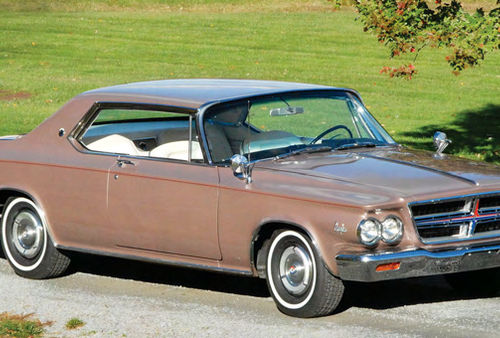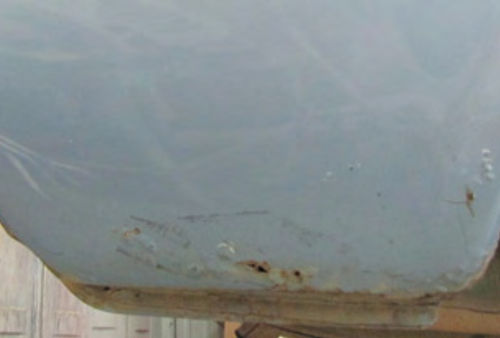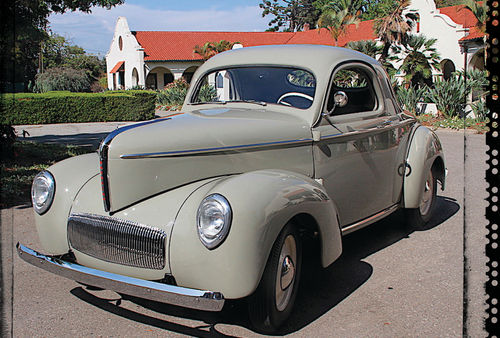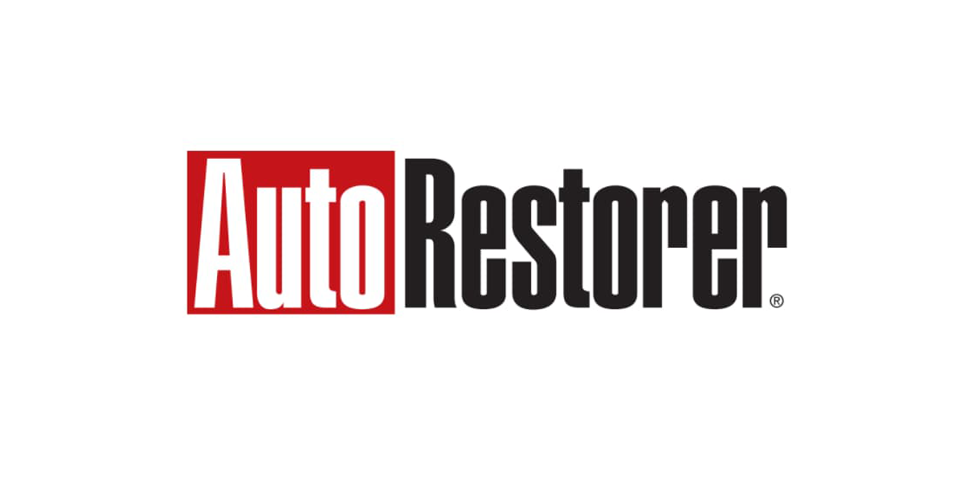What you need to know about replacing the wraparound windshields for your '50s car.
Anybody who grew up in the 50s had to be dazzled by wraparound windshields, those goldfish bowls from the golden age of gorp. I think Tom McCahill offered the best comment about them when he wrote in 1955: “Those wraparound windshields give me wraparound eyeballs, and if I ever get my hands on the guy who invented them, I’ll wrap one around his neck.”
The guy was Harley Earl, head of GM styling who promoted two of the wildest 1950s show cars, the Buick LeSabre and the XP-300. When Earl first came up with the idea of the wraparound windshield, the engineers at Libby-Owens-Ford were dumbfounded. But after realizing he was dead serious and taking note of who their biggest customer was, they managed to come through. It wasn’t easy battling the distortion problems though.
GM’s first production wraparound windshields appeared on the limited production 1953 Cadillac Eldorado and Oldsmobile Fiesta. For 1954 they turned up on Cadillac, Buick and
Oldsmobile, but not Pontiac and Chevrolet. In 1955 the whole industry went wraparound windshield wild and the party lasted until 1960. Even Packard, Hudson and Nash had them.
Forty years later many of those wraparound windshields are cracked and pitted. In restoring vehicles of this era the question of a replacement windshield will inevitably arise. Does anyone manufacture wraparound windshields for my particular make and model? And if so should I go for the new replacement or settle for good used?
We contacted several well-known suppliers in this country. Most were reluctant to answer questions. But three companies, OEM in Illinois, Auto City Classic Glass in Minnesota, and Jim Winter in Pittsburgh, gave us most of the answers we were seeking.
Reproduction Windshields

Can you still get new glass for wraparound windshield cars? The answer is “yes” for just about all of them. For instance, many restorers of Chrysler vehicles who had been previously impeded in their search for glass now are finding it available. In fact, the only windshields we could find that are not being made are for the 195556 Packard convertibles and the 195557 four-door Nash Statesman and Ambassador. Much of the glass is foreign made, and for good reason. In the limited quantities that it is being manufactured today, U.S. manufacturers simply can’t compete. We did find some glass manufactured in Minnesota, but most is being produced in South America, specifically Peru. There are also some manufacturing sources in Finland and Taiwan, and in fewer instances, it comes from South Africa.
We were told the price of the glass from Peru has been increasing 30 percent a year due to the inflation rate of that country. Economic instability in foreign countries and the overall uncertainty of international trading means that any glass price quoted today may not apply tomorrow.
Quality of Glass, Ease of Installation
It is important to realize most of the new glass made for vintage vehicles today is slightly thinner than the original, but is the same thickness as modern auto glass. Does that mean it’s not as strong? According to John Buzick at Auto City Classic Glass in Ham Lake, Minnesota, it is every bit as strong because glass-making technologies have improved so much in the last 30 or 40 years. It will fit with no problems providing (This is the important part.) you use the correct rubber weather stripping. Be forewarned, however, that some weather stripping is too tight. It will pinch the glass and easily crack it. This is one reason why most restorers seek out a person with experience installing wraparound windshields. It’s your toss of the dice, but attempting to save installation costs only to break the windshield seems like a bad bet.
Assuming you go to a professional glass shop, the owner should be able to obtain the correct windshield for you. You may pay more than if you purchased directly from the firms who specialize in old car glass, but you will have a guarantee. If the installer breaks it, his company pays for a second windshield. This is an important consideration when you are paying $400 or more for a windshield. If your glass installer says he can’t find your particular windshield, show him the list of suppliers at the end of this article. If one of them does not have your particular glass, surely another will.
Some shops will not install wraparound windshields. There are several tricks to it. Ask any shop you are dealing with whether their workers have experience installing this type of windshield. Some installers cater to the hobbyist. But many do not.
For all intents and purposes any glass that was once made can be made again. What you need is a mold and that can cost as much as $10,000. Once your glassmaker makes a mold for you, you can turn out as much glass as you want. Sand is still cheap. The final price depends on the popularity of the car. A lot of people are restoring 1955-57 Chevrolets, therefore, windshields cost as little as $170. But how many people are restoring 1953 Cadillac Eldorados, of which only 533 were built? The windshield cost is $995 clear or tinted. It all gets back to amortizing the cost of the mold.
If you are restoring a popular ’50s car, you can be sure that there is a plentiful supply of new glass, some of it even with the correct original factory logos or “bugs.” Expect to find availability and very competitive prices for 1953-62 Corvettes, 1955-57 Thunderbirds, and all Chevrolets in the ’50s. Glass for 1955-58 Fords is considerably more expensive than for Chevrolets, because there is more demand for the Chevrolet glass of. this era. Glass is available for 1958-60 Thunderbirds, but it costs more than twice as much as for 1955-57 Thunderbirds. This is a clear lesson in supply and demand. You can even get glass for 1956-57 Continental Mark IIs and 1957 Cadillac Eldorados, but expect to pay a hefty price because not many people are restoring these automobiles. They still make windshields for the original wraparound windshield cars, the very rare 1953 Cadillac Eldorado and Olds Fiesta. Again, the prices are high because these cars are in short supply.
Recognizing that Windshield
Interchangeability is important to know if you are buying a windshield, whether it is newly manufactured, used or new old stock (NOS). The wraparound windshield era began with 1954-56 Oldsmobiles, Buicks and Cadillacs. But even at this early date they did not all use one wraparound windshield. The GM C-body windshields for the big cars are quite a bit different than the B-body or mid-sized cars. The C-body windshields for the Cadillac and Buick Roadmaster and Super have a pronounced dip at the bottom and the
A-pillar is straight. Convertible and hardtop windshields are not the same as the sedan. B-body windshields for the Olds 98, Buick Century, Buick Special and Olds 88 do not have the dip at the bottom and the A-pillar is swept back at the base. Convertible and hardtop windshields are not the same as sedan.
The 1957-58 Cadillac windshields are different than the earlier years. There are different windshields for different body styles. Convertible and hardtop windshields are interchangeable with each other, but not with the sedans. The windshield for the 195758 Cadillac Eldorado Brougham is not the same as for the DeVille hardtops. The 1957-58 Buick Roadmasters and Supers have the same windshields as 1957-58 Cadillacs. The 1957-58 Buick Centurys and Specials carry the same windshield as all 1957-58 Oldsmobiles. One windshield (W518) fits all models for 1957 and one windshield (W514) fits all models for 1958, but 1957 and 1958 windshields are not interchangeable. Except late-1957 carries the 1958 windshield.
In 1959 and 1960 GM used the same body for all makes from Chevrolet to Cadillac, hence there were only two windshields, one for the convertibles and hardtops and another for the sedans and wagons. It would be nice if all makes and years could be that simple, but they’re not.
The 1955-57 Chevrolet has four different windshields. The 1955-56 convertible, hardtop and Nomad all have the same windshield, W396. The 195556 sedans and station wagons have the same windshield, W394. The 1957 Chevrolet has different windshields than 1955-56. It is W512 for the convertible, hardtop and Nomad; W513 for the sedan and station wagon.
If you have a 1958 Chevrolet, you have an entirely different windshield. One windshield fits the Impala convertible and hardtop, another fits all models in the Bel Air, Biscayne and Del Ray series. Study these cars carefully and shop around before you buy. Since a lot of 50s Chevrolets are being restored there are a lot of windshields available, and prices will vary considerably from one source to another.
If you’re restoring a 1955-57 Pontiac it has all the same windshields, with the same numbers, as the 1955-57 Chevrolet. This is also true of the 1958 Pontiac. But the 1958 Pontiac and Chevrolet windshields are not the same as the 1958 Oldsmobile and Buick.
When it comes to Fords, the 195556 windshields are not so easy to interchange. The 1955 Ford Victoria windshield fits the standard ’55 sedan and even the 1956 four-door Victoria. It will not fit the 56 Crown Victoria or the 1956 Ford Victoria two-door model that has the same windshield as the Crown Victoria. So be extra cautious when buying glass for these cars, especially if you’re buying a used piece. The 1955-56 Mercurys have the same windshields, but these windshields defy all the normal rules of one number for hardtops and convertibles and another for sedans and wagons. There is such complexity here that you must consult a National Auto Glass Specifications catalog, commonly known as the NAGS catalog, for your particular year and body style or see a collector car glass specialist.
The 1957, 58 and ’59 Fords are much easier. One windshield fits the 1957-58 Ford Fairlane and Fairlane 500 and convertible, another fits the 1957-58 Ford Custom sedans and wagons. For 1959, which was the last year of the Ford wraparound windshield, the windshields are very different from 1957-58. One windshield fits the convertible and retractable hardtop, and another fits all other models.
For 1957-58 Mercurys, one windshield fits every model except the Turnpike Cruiser. Contrary to what some suppliers may tell you, the Turnpike Cruiser windshield is being made. The largest wraparound windshield ever made fits into the 1959-60 Mercury. These cars are rarely seen, but the windshields are still being made. Edsel windshields are no problem. They are the same numbers as Ford or Mercury windshields depending on your model and year. The 1958 Rangers and Pacers carry Ford windshields because they have essentially Ford bodies. The 1958 Corsairs and Citations carry Mercury windshields because they have essentially Mercury bodies. For 1959, Edsel windshields are the same as 1959 Fords. In 1959 Edsel dropped the Mercury body.
In the case of the Thunderbirds, one windshield fits all years 1955 through 1957, and one windshield fits all years 1958-60. It doesn’t matter if you own a convertible or hardtop.
Lincoln would seem to be a likely candidate for oddball windshields that are no longer available. Not so. The 1956-57 Continental Mark I had only one windshield and it is conveniently available for a price. All models of the 1956-57 Lincoln carried only one windshield, even the convertible. The same is true of the 195860 Lincoln models. All of the 50s Lincoln wraparound windshields are still being made.
Until recently, obtaining windshields for Chrysler products in the late-’50s and early-’60s was quite a problem. Most all were being manufactured, but many did not have the correct bubble. Because this was well known, those who had correct used windshields or new old stock for sale were charging a fortune. That has changed with the reproduction windshields from Finland and Peru.
The 1955-56 Plymouth and Dodge windshields are interchangeable to a degree and readily available. Convertible and hardtop windshields are the same. Sedan and wagon windshields are different. The 1955-56 DeSoto and Chrysler windshields are being made and these same windshields fit 195556 Imperials. There is one windshield for the convertible and another for the hardtop and sedan. The 1957-59 Plymouth and Dodge convertible windshield (W453) is now being made. So is the two- and four-door hardtop windshield (W451). The sedan and wagon windshield (W454) is also being produced.
Windshields for the 1957-59 DeSoto and Chrysler are interchangeable with the Plymouth and Dodge. The 1960 Plymouth/Dodge/DeSoto windshields are the ones with the big bubble at the top, and now this windshield is being reproduced to its exact dimensions. It seems safe to assume some of the incorrect reproduction windshields (no bubble) remain on the market, so beware.
Chrysler was the last manufacturer to offer wraparound windshields. Dodge and Plymouth had them through 1961. They are the same windshields that were used in 1960. DeSoto used a wraparound windshield through its last year of manufacture, 1961. Chryslers continued to feature a wraparound windshield through 1964. From 1957 through 1963 Imperial used the same wraparound windshield for all models.

Packard, Studebaker, Hudson, Nash and Rambler windshields are being made. There also seems to be a good supply of new old stock and good used windshields for these makes.
Have you got the bug?
A word about logos or “bugs” in windshields. This may not be important to some collectors, but if you are restoring a competitive show car it should be important to you. Auto City Classic Glass and OEM are the only companies licensed by the manufacturers to use their corporate logos. When you are buying a new windshield always ask if it has the correct factory codings. If it does not, it isn’t worth as much as a windshield that has these codes. Before you search for any 1950s windshield — new, used or NOS — send for the NAGS Auto Glass Parts Catalog #60. Published by National Auto Glass Specifications, Inc. It gives you the correct parts numbers and sizes for all U.S. cars and trucks (1941-1960). It also includes an interchangeable parts section. This catalog can be obtained by sending a check for $20.07 to National Auto Glass Specifications, P.O. Box 1065, Warren, MI 48090-1065.
What about Used?
There is a market for used windshields, but according to Rick Peak at OEM it’s not much of a market — less than 1 percent of their business. Jim Winter in Pittsburgh is one source that does specialize in NOS and used glass. He says the amount of used glass sold is 10 percent to 15 percent of the market. Auto City Classic Glass tells us they destroy their used windshields. They say it makes no economic sense for their customers to purchase them.
Still there are restorers who will buy used glass for a number of reasons. Frequently you can obtain a used windshield from a fellow hobbyist for $100 or less. If you have the skills to install it yourself, that’s a relatively small investment compared to the cost of new. But if you have a glass shop install it, it may cost you another $100 and there is no guarantee against breakage when they are installing it.
If you want to learn how to install wraparound windshields, starting out with an inexpensive used one is a good way to practice. Wraparound windshields are installed like any other windshields with one important difference. You cannot work one side and then the other. You have to work both sides evenly. Applying more pressure at one end than the other may break the glass.

If you are going the used-windshield route, having a NAGS book and knowing about interchangeability is very important. But you should be aware of all of the problems involved with used windshields. More often than not they are pitted, scratched or cloudy. Sometimes laminates have separated or there are bubbles. They may look fine until you drive into the sun, then you can’t see a thing for all the pits that have accumulated.
Another potential problem with used glass is that it has a memory. When a windshield has been in a car for 40 years it has become comfortable in its surroundings including the pressures that are applied within its framework. When the glass is removed from its original framework, there is the possibility that it may crack just sitting on a shelf. Also, the new stresses of being squeezed into a different windshield frame can cause fractures. This doesn’t happen often, but it does happen.
Where do you find used glass? For the most part the major suppliers do not stock it. When they get a request they go to the same sources that you can go to — salvage yards, people in the hobby who deal in parts for particular makes of cars, and glass dealers who do not specialize in collector cars, but who may have their own special connections in the car hobby.
OEM does not stock used glass. Jim Winter does. If he finds a car with particularly good glass, he will save it. This is especially true of back glass (rear window glass). Very little back glass is being manufactured so if you need a replacement you have to go to used. On the other hand, there is less demand for back glass because it seldom cracks, pits or breaks.
How about NOS?
There isn’t much new old stock available, but it is out there. Jim Winter has some, even in the original boxes. The manufacturers do not have it. Older glass shops may have some, especially the mom and pop operations. Car collectors may have some. But finding NOS for your particular make and model will not be easy. The cost is generally higher than buying reproduction glass for your classic. NOS glass is not like stainless
steel trim or many body and engine parts. It does deteriorate. Laminates separate and it does discolor even when it is stored in its original box, in the dark for 40 years. It has been subjected to temperature and humidity variations. Theoretically, if it had been kept in its original carton in a climate-controlled warehouse for all those years, it might be in great shape, but in practice that just doesn’t happen.
Although nearly every American wraparound windshield is now being made, choices are not always going to include clear, tinted or shaded. Because of the availability of reproduction wraparound windshields, there is a diminishing interest in used glass. Still, a good used wraparound windshield can be a real bargain if you have the skills to install it yourself or know of someone who can install it for you at a reasonable price. Basically, if you are restoring a car for show, you definitely want a new windshield. If you just want to replace a cracked windshield in your driver, check out the interchangeability and go for the used.
















